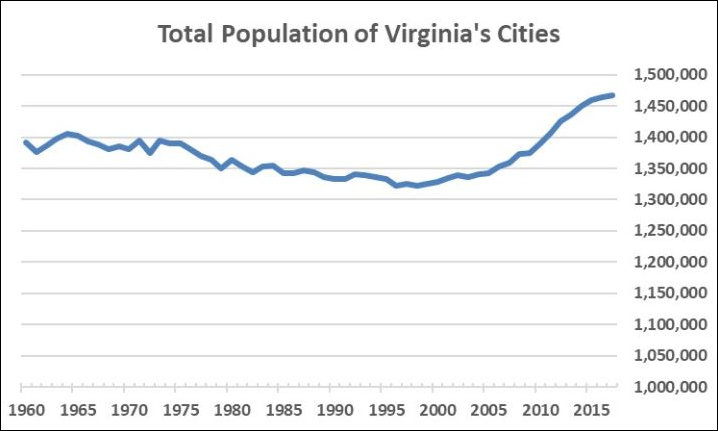After a decade of strong growth, the population of Virginia’s cities may be leveling off, says Hamilton Lombard with the University of Virginia’s Demographics Research Group. The rising cost of housing in Virginia cities is pushing households into neighboring counties, he says.
The major swing group is households with young children. For decades, families with young children moved from cities to counties in search of better schools. After the 2007 recession, Lombard contends on the StatChat blog, many families found it difficult to purchase a home, so they rented in cities where a larger share of the housing stock is rental homes. As a result, the share of children in city populations increased, leading to an unexpected surge in school enrollments in many cities. Over the past 10 years, cities accounted for seven of the 10 fastest-growing school divisions.
Lombard expects cities to hang on to their population gains, but he suggests that continued population growth will be difficult to maintain. The main problem is the difficulty of building new housing. In Virginia cities, vacancy rates are declining, and housing prices are increasing. Prior to the recession, for example, owner-occupied housing in both Charlottesville and Richmond was 27 percent cheaper than in surrounding counties. By 2016, housing was only 12 percent cheaper in Charlottesville and eight percent cheaper in Richmond.
Concludes Lombard:
In the coming years, home construction levels will need to increase for Virginia cities to continue growing at recent rates. Some cities, such as Richmond, have seen more home construction. But building new homes in cities can be difficult; most development in cities is infill which often requires more paperwork and faces more public opposition than greenfield developments.
If cities are not able to supply enough housing to meet demand, the recent trend of falling vacancy rates and rising home prices will likely continue, along with slower population growth.
Bacon’s bottom line: I concur with Lombard’s analysis. Cities have limited space for infill development, and established neighborhoods resist re-development at higher densities. There is a significant unmet demand for walkable urbanism found in the traditional neighborhoods of Virginia’s cities, both large and small, but people have to live somewhere and they will buy what they can afford, even if the surrounding amenities are not what they would prefer. I expect we will see “sprawl by default” — scattered, low-density, single-use development, not because it’s what the market demands but because that’s what counties zoned for in the go-go days of the early 2000s and that’s what’s in the supply pipeline.



